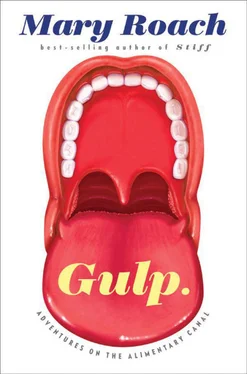Tracy has no funding for the experiment, just enthusiasm. He calls up colleagues and acquaintances and tells them what he’s fixing to do, and they jump on board with offers to help. Walt Mandeville, the university veterinarian, has volunteered to do the sedating. Tracy’s grad student Lee Lemenager will be manning the endoscope. Lee has the kind of face that children draw when they first begin to draw faces, everything round and benign. Earlier in the day when he dripped gastric acid on a superworm, it seemed like a friendly thing to do.
“And this is Frank and Terry, from OMED,” says Tracy as two more men show up in the lab. OMED of Nevada sells used medical equipment. “They lent us tens of thousands of dollars of video equipment that is forty years old and probably worthless. Welcome!” Tracy is one of those supremely likable professors whom students keep in touch with long after graduation. The back wall of the Tracy Laboratory is covered with photographic portraits he has taken of his grad students. His white hair suggests he may be closing in on retirement, but it is difficult to imagine him golfing or watching daytime television.
Tracy holds a bullfrog in sitting position while Lee feeds the scope into its mouth and down to the stomach. We aim to spy on a superworm swallowed less than two minutes ago. The endoscope, which is a flexible tube of fiber optics with a tiny camera and light at the end, is hooked up to a closed-circuit video monitor so that everyone can watch, and Tracy can film, what’s happening inside the stomach.
The frog is sedated but awake. It glows like a decorative table lamp, the kind that sets a mood but is not sufficient to read by. The screen on the monitor is solid pink: the view from inside a well-lit frog stomach. You don’t expect any part of a frog to be pink, but there it is, pink as Pepto-Bismol.
And then suddenly: brown. “There he is!” Lee focuses down on telltale bands of brown, tan, and black. The superworm is not moving. To see whether it’s even alive, Walt the veterinarian inserts a pair of biopsy forceps through the makeshift speculum that Lee slid down the frog’s esophagus at the beginning of the experiment. The jaws of the forceps gently squeeze the superworm’s midsection. It squirms, electing a spontaneous Broadway chorus: “It’s alive!”
“Is it chewing?” someone asks. As if by director’s cue, all heads lean in.
“That’s the tail,” says Walt the vet. Walt has a keen observational eye, honed by a span of years as a poultry inspector (“4.8 seconds per bird”).
Lee pulls back on the endoscope and works it over to the other end. The superworm’s mouthparts are still. Nothing is moving. Walt tells us about a phenomenon he calls the “blanket effect.” To calm a wild horse prior to treating it, a vet may herd the animal into a narrow chute lined with packing peanuts that gently presses in on its sides. It is the same principle behind swaddling an infant or hugging a distraught friend or dressing a thunder-phobic dog in an elasticized Thundershirt, available in pink, navy, and heather gray. Mercifully, stomach walls seem to act as a mealworm Thundershirt.
Before the superworm was presented to the frog, Lee looped a thread around its middle and secured it with surgical glue, so he could retrieve it later. Now that time has come. The frog surrenders its lunch seemingly without concern, and the superworm is left in a petri dish to recover. John Gray goes to get a chuckwalla, placing the superworm back behind the lizard’s teeth. Same result. The superworm quickly goes still but does not die.
One thing is clear from these experiments. Mealworms are not much troubled by gastric—that is, hydrochloric—acid. Many people, including myself when I began this book, think of hydrochloric acid more or less the way they think of sulfuric acid, the acid of batteries and drain cleaners and hateful men who wish to scar women’s faces. Sulfur likes to bind with proteins, radically altering their structure. If that structure is your skin, you come away from the experience disastrously altered. Hydrochloric acid isn’t as caustic.
For me the confusion can be traced to the movie Anaconda , the scene in which the giant snake rises from the water to regurgitate Jon Voight’s character, his face melted like wax. Some time back, I visited the lab of my favorite snake digestion expert Stephen Secor, the technical consultant on Anaconda. I told him I wanted to experience gastric acid, to get a sense of what it might feel like to be alive inside a stomach. He made me promise not to tell his wife, who oversees safety protocol for the university’s labs, and then he took a bottle of hydrochloric acid off a shelf and put a dab—five microliters—on my wrist. I braced for sharp heat, as from a drop of scalding water. It was a full minute before I felt anything at all, and then only a weak itch. He added another drop. At three minutes, the itch turned to mild irritation, which held more or less steady for twenty minutes, then faded to nothing. It left no mark.
But stomachs secrete more than a single drop of hydrochloric acid. And they keep on secreting, readjusting the pH as the digesting food buffers the acid. My guess is that the situation inside an actively secreting stomach lies somewhere between what occurred on my wrist and what happened to the Japanese factory worker who fell into a tank of hydrochloric acid seven feet deep. The case report states that his skin turned brown and the delicate tissue of his lungs and digestive organs underwent “dry coagulation necrosis.” Burning—whether from acid or from heat—denatures proteins. It changes their structure. It is denaturing that solidifies the boiling egg, that curdles milk, that distorts the burn victim’s skin. Inside a stomach, hydrochloric acid denatures edible proteins, making them easier for digestive enzymes to break down.
The effects of gastric acid are insidious but far from instantaneous, especially if the eaten entity is, like a superworm, protected by an exoskeleton. Crabs vomited after three hours in the stomach of the Asian crab-eating snake Fordonia leucobalia have been known to stand up and run away. I have an eyewitness for this: University of Cincinnati biologist Bruce Jayne. Jayne had “gently massaged” the snakes’ bellies to get them to surrender what they’d eaten, so he could tally it for his research. Because you can’t just ask them.
But without Bruce Jayne to massage the belly, without Lee Lemenager to pull the surgical thread, without God making the whale regurgitate, there would seem to be no way out.
Parasites are the exception. “Parasites bore all over the place,” says Professor Tracy. Some are equipped with a boring tooth, like a drill bit installed on the top of the head. “That’s what they’ve evolved to do. But these are mealworms, for crying out loud.” Larvae burrow, but they don’t bore. “How the hell would they know to tunnel out?” Walt the vet agrees. He is off and running with a story about the giant kidney worm, a parasite that bores out the entire organ and then exits the body through the urethra. He jerks his elbow toward the endoscope. “You could watch it coming with that scope.”
TRACY IS GOING to give the superworms one last chance, the best possible chance, to see if they can chew their way to freedom. They will be put inside a dead stomach—one with no secretions and no muscle contractions.
Where do you find a stomach on a Thursday afternoon in Reno?
“Chinatown?” suggests someone.
“Costco?”
“Butcher Boys.” Tracy pulls his phone from a pocket. “Hello, I’m from the university”—the catchall preamble for unorthodox inquiries. “I’m wondering, is there any chance at all we could get a fish stomach from you?” Tracy waits while the man goes to ask someone and/or make twirling finger motions at his temple for the benefit of his coworkers. The lab falls quiet. The feeder crickets chirp in the next room. “No stomachs of anything? No. Okay.”
Читать дальше












